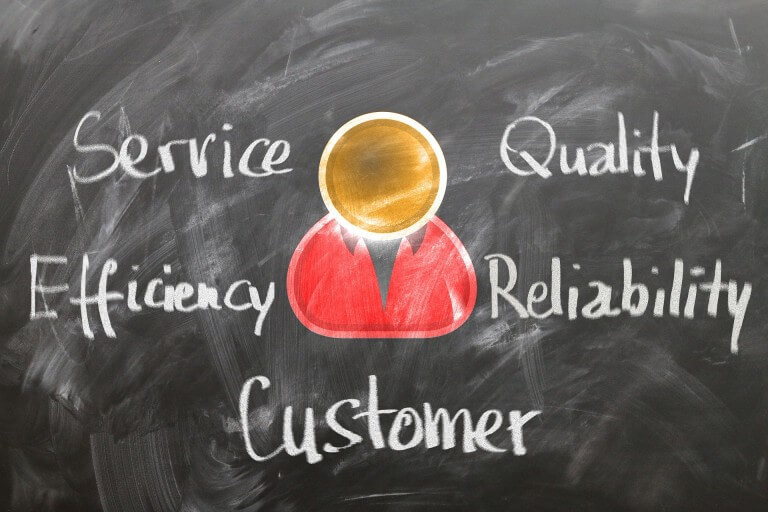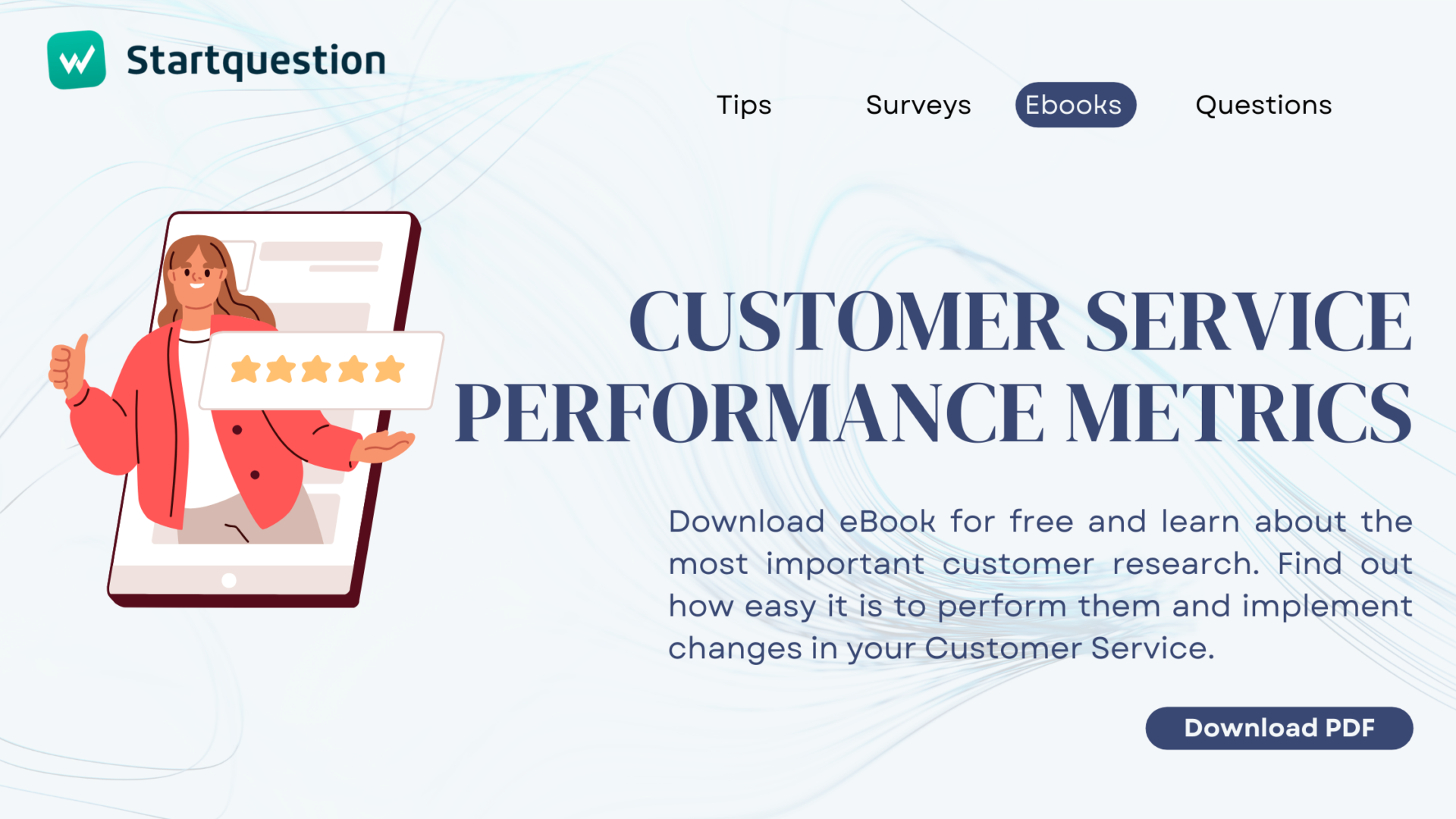As a business owner, I dream about a situation in which you have only loyal customers. The holy grail of e-commerce – a costless and unsophisticated client who is constantly buying, recommending your products and services to others. I have bad news for you — there is only a handful of such people. Those who are less loyal, dissatisfied, more demanding, and more expensive will always form a bigger group. In order to change this, you will need to properly study customer satisfaction. Try my tips and help yourself increase customer loyalty!
If you represent a monopolistic business, you can give this article a miss. Customer loyalty has nothing to do with your company’s success. If a client has no choice, he or she will stay with you whether satisfied or not.
Startquestion is a survey software
Gather feedback via weblink, social media, email, and more.
No credit card required · Cancel any time · GDRP Compilant
However, if you are not a monopolist and you sell products or services, continue reading the article. You will find out what to do to decrease the number of disloyal customers and increase the number of loyal ones. On top of that, you will discover the opportunity to automate the majority of customer satisfaction research processes. You’ll also see how to properly react to “fuck-ups” and transform dissatisfied blusterers into your brand believers.
Customer satisfaction is not loyalty
Please remember that loyalty is a much bigger term than satisfaction. A satisfied client will very likely buy your product again. That’s it.
Loyal customer does not guarantee growth in the short period, but gives you something more — he or she becomes you brand ambassador. Loyal customer is willing to put own reputation to risk and recommend your business to friends. He or she participates in and is responsible for the results of your company’s actions. That’s why customer satisfaction research should be called customer loyalty research.
Foregoing customer „satisfaction” research is not enough anymore
Customer satisfaction research in many companies is still an annual, one-time event. In the best-case scenario, it is organized twice a year. Irregular and rare studies will cause you more trouble than profits. The two most important problems are:
1. Big number of answers which are difficult to analyze and to react to.
Quantitative data (satisfaction or loyalty indexes) will only show the size of it, but won’t tell you the reasons for it. This is why qualitative analysis is the most important but also very time-consuming part of customer satisfaction research. Did you put an open-end question in a survey? Great — you know that you can find an answer for what positively and negatively influences customer loyalty there. How many clients do you have? Let’s assume you run a middle-size business with 10,000 clients. 10% answered your open question. You have 1,000 responses — good luck!
2. Anonymity of the sample that doesn’t give you an opportunity to react immediately and solve a specific problem on the spot.
Customer satisfaction research is conducted on anonymous sample in most of the cases. You cannot relate to a specific client. You don’t know who exactly has a problem. You cannot ask for details, apologize and fix an issue. You react only on a general level and what’s even worse — with a big delay.
Remember that immediate company response for a negative customer review is a critical factor for customer loyalty and satisfaction improvement. If you conduct your study every 6 months you allow yourself NOT TO LISTEN to your clients for half a year! How many things may happen in that period? Naturally, it will influence your company’s income after 2–3 months, but it might be too late to fix it.
How a good customer satisfaction research should be conducted?
First thing, don’t forget why you do the study. Good research:
- keeps you up-to-date with the level of customer satisfaction/loyalty;
- answers question: what makes satisfaction increase/decrease;
- enables you to react to negative opinions (closing loop);
- is short to increase a chance that a customer finishes a survey;
- is aimed at different people in a minimum period of 1 quarter.
Start with sending an invitations to fill such survey everyday (yes, everyday), but only to 0.5% of your clients. Every day let it be a different 0.5% of customers until you reach the end of the list. Then you start over.
How to create an effective questionnaire for customer satisfaction research?
Preparing a brief questionnaire which gives you the maximum of information about your clients is the base. Prepare it based on 3 questions.
Question 1 — Net Promoter Score (NPS)
NPS is a basic index to measure customer loyalty. It was developed by Frederick F. Reichheld and its roots were presented in Harvard Business Review in December 2003. Assumptions of the index are not random, but naturally stem from broad studies that were conducted by Reichheld in cooperation with research company Satmetrix.
Studies indicate that the higher NPS for your company is the higher income you get and the higher company growth potential is. Correlation is not dependent on industry, market, or customers’ nationality. If loyalty rises the income grows too. If loyalty decreases income drops.
Question 2 — Argumentation
It is the essence of the whole research. It is anything but a descriptive extension of evaluation from the first question. Precise analysis of answers in argumentation will help you find out about what you should pay attention to when trying to increase customer loyalty. I don’t know it today. You will do because you know your business and you know how argumentation is related to provided service.
Argumentation (e.g. “We’re sorry that our products do not meet your expectations. What can we do to get a better mark next time?”) can appear only when we deal with detractor (person who gives 0–6 answers). However, we can also ask for argumentation in the case of higher grades, i.e. neutral passives (7–8) and promoters (9–10). Then questions will be: ‘Is there anything we can do to make you evaluate us better the next time?’ and ‘Thank you for a high grade! Could you tell us why we deserved them so we can nurture our best practices?’
Question 3 — Driver
You will find out here which component (driver) of your service positively or negatively influences satisfaction. It is a clear information about what you should handle in the first place. It is also a perfect criterion to filter results. If you are receiving too many opinions every day you can set rules which will transfer reviews with low NPS results and/or in a specific driver. In the case of opinions from clients who are dissatisfied with customer service the analysis falls on a person directly responsible for your customer service department. You don’t need to handle it. You just delegate the right results to the right people who have adequate competencies to solve the problem.
The 3 questions are enough. Don’t try to cram more, you don’t need them. You already know what is your customer satisfaction level, you know why it is like it is and you know what influenced it. Further questions make for unnecessary confusion and decrease response rate. You asked 20% of the questions which gives you 80% of conclusions. More questions will not be translated into a significant improvement in knowledge about clients.
What will you get by collecting answers in this particular way?
- You conduct customer satisfaction research on a daily basis so you don’t take a risk that something escapes you notice within the following waves of research.
- You read a few opinions about your service everyday with pleasure (good read to the morning coffee).
- This amount of information is enough to catch the most critical facts.
- Questionnaire is very short so fulfilling it will take only 1–3 minutes, depending on what responded writes in an open-end question.
- Thanks to the question 3 you exactly know what influence customer satisfaction level.
Loyal/disloyal client — how can you use them?
- Survey is just a tool for collecting information. You know now what and why is going on and you can act. Both speed and form of reaction are the key to customer satisfaction and loyalty. To simplify this, response to client’s opinion can have two forms: putting out fires or supporting positive opinions.
- The faster putting out fires is the smaller damages are. If you help your customers effectively and timely, you have a big chance to turn your dissatisfied client (detractor) into fan (promoter). Such client might become even more loyal than the one who have not had any bad experiences with service. The one with “experiences” knows how you behave in crisis situations and knows that in the future he can count for your support. It was scientifically proved and named Service Recovery Paradox
- We reach the very important point here. Customer loyalty can be easily built on putting out fires after negative experience. Don’t spark so-called “controlled fires” just to enhance customer loyalty. The risk might not pay you off. However, be prepared for possible contingency — if you are aware of such scenario, you will see a “fuck-up” as an opportunity, not as a threat.
- Promoting positive opinions is another way to react to positive feedback of a high potential. For instance, give your promoter (9–10 answers in NPS) an incentive to like your company page on your social media. As a client declares that he or she will recommend your company you should give them a chance to do it. Thanks to that not only will you increase your reach in form of the number of followers or fans, but also you can use received opinions as perfect marketing content. It is always better when the clients praise us rather than when we do that on our own 🙂
Closing the loop = improving loyalty
- Everything what you read in the previous section is called closing the loop. This is a recipe for improving your customer loyalty.
- The main reason why clients leave a company is their dissatisfaction with service. 60–70% of people change provider because of this reason. And what’s customer service but closing the loop? A client who doesn’t get help, leaves — easy!
Classic, reactive customer service (answer to a question) serves only those who have time and will (or are not satisfied) to contact you to describe your problem. There is much bigger group of clients who leave unless you ask them.
Proactive actions, e.g. satisfaction monitoring, significantly improve the customer service department.
Good practices for closing the loop:
- Analyze results of surveys on a regular basis. Don’t let anything to surprise you.
- You’re not able to answer all dissatisfied customers? Decrease the number of sent invitations. Lack of answer is own goal. It is better not to question at all in this case.
- Start your analysis with responses with the lowest NPS (0–6).
- Thank when you reply to negative opinion. Make commitments you are able to fulfill (consult it beforehand with coworkers what can and what cannot be done).
- Negative answer cannot wait long for your reaction. If you count reply time in minutes you have 80% chances to save a client. After a month — only 20%.
- Good opinions is a perfect material for marketing promotion in social media. It is tactless to overpraise yourself.
- Make all the coworkers in your company to catch NPS bug. Make research result available to people who are responsible for particular drivers — delegate closing the loop.
Check out if it works – quick research
If you are not convinced yet, make quick research on a 10% sample of your clients. Remember to provide answer identification. After you get results, compare answers to NPS question to financial results and customer lifetime. You will see that those who checked 9–10 marks generate more money for your company and leave less often. On the other hand, those with 0–6 answers are related to measly incomes.
Monitor behavior of detractors who are closed in the loop. Check if the others stay with you and if they buy from you.
The type of research described above is a relationship research. It is a basis for transactional customer satisfaction research , which is executed after every customer contact with a company, in so-called touchpoints. Transactional research is a wide term for a totally different article.
In the case of the rule: relationship and transactional customer satisfaction research are complimentary. However, there are industries, in which only transactional research applies (e.g. tour operators, insurance companies. In that case, research is conducted directly after coming back from a trip or after the warranty worked. But we will cover it in the next entry.




